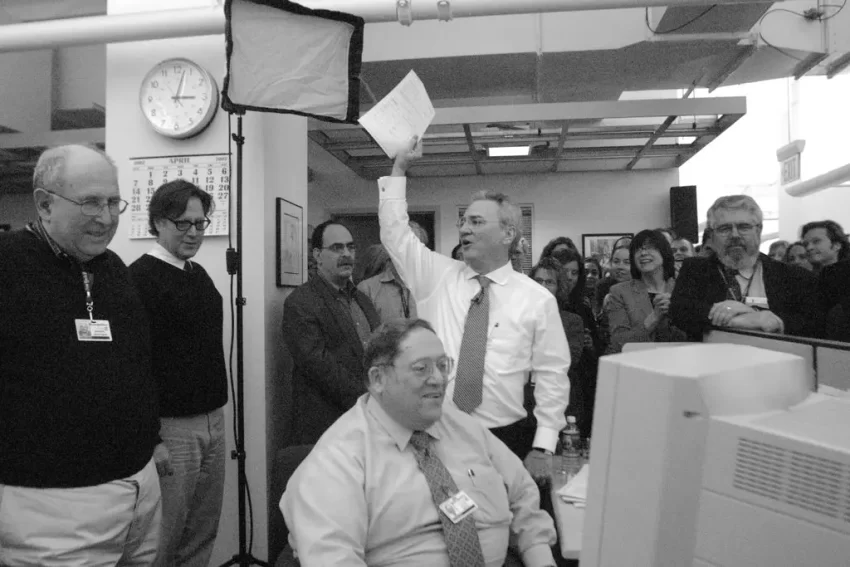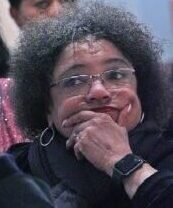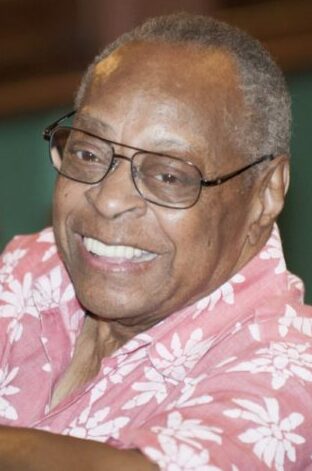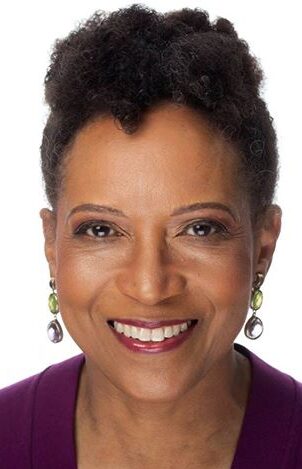
Howell Raines, New York Times executive editor, announced the 2002 Pulitzer Prizes as Allan Siegal, seated, monitored the news online. (Credit: Joyce Dopkeen/New York Times)
(From a longer column)
“Allan M. Siegal, a former assistant managing editor of The New York Times who left a deep imprint on the newspaper’s policies and practices as its exacting and unquestioned arbiter of language, taste, tone and ethics for 30 years, died on Wednesday at his home in Manhattan. He was 82,” Todd S. Purdum reported Wednesday for the Times.
Black journalists gave Siegal credit for his attention to diversity.
 “Many people had problems with Al and feared him. Angela P. Dodson (pictured, below), a Times editor from 1983 to 1995, wrote fellow Times alums. “What his obit does not seem to give him credit for is that Al was one of the greatest forces in bringing diversity to the Times, especially in the copy editing/section editing etc. ranks.
“Many people had problems with Al and feared him. Angela P. Dodson (pictured, below), a Times editor from 1983 to 1995, wrote fellow Times alums. “What his obit does not seem to give him credit for is that Al was one of the greatest forces in bringing diversity to the Times, especially in the copy editing/section editing etc. ranks.
“He interviewed me and had lunch with me before I was hired in 1983. I think he recommended me for every promotion after that. I reported to him at least weekly when I was Living editor and Style editor in the late 1980s-90s. (My career didn’t go so well after I [changed departments]. In my experience, he also advanced the careers of many other editors of color. He would also ask our opinions on matters of style involving African Americans etc.”
 Paul Delaney (pictured), a former senior editor at the Times who worked there for 23 years, messaged, “al was a serious, no nonsense powerful editor. he struck fear in newsroom, very unlikable, 2d only to abe [Rosenthal]. he was a behind the scene, quiet presence & big supporter of integrating nyt newsroom. for some reason, he took a liking to anita & me & he & wife had us to dinner at their apt sevl times & they came to some of our parties. we got along well, unlike others.”
Paul Delaney (pictured), a former senior editor at the Times who worked there for 23 years, messaged, “al was a serious, no nonsense powerful editor. he struck fear in newsroom, very unlikable, 2d only to abe [Rosenthal]. he was a behind the scene, quiet presence & big supporter of integrating nyt newsroom. for some reason, he took a liking to anita & me & he & wife had us to dinner at their apt sevl times & they came to some of our parties. we got along well, unlike others.”
 Mary C. Curtis (pictured), now a columnist for Roll Call, messaged, “As someone who was a section editor, backfield editor and copy editor at The New York Times from the mid-1980s through the mid-1990s, I interacted with Al quite a bit. I can honestly say we liked and respected each other, though his reputation as being tough was well-earned.
Mary C. Curtis (pictured), now a columnist for Roll Call, messaged, “As someone who was a section editor, backfield editor and copy editor at The New York Times from the mid-1980s through the mid-1990s, I interacted with Al quite a bit. I can honestly say we liked and respected each other, though his reputation as being tough was well-earned.
“But he was also extremely fair.
“He offered me helpful criticism, as well as praise when he believed I deserved it. I also know he spoke well of me to others, from the time he saw my editing test, and can’t help feeling that had something to do with my editing top critics on the culture desk and filling in as editor on weekends right away. When I first had to pitch stories for Page 1 in the news meeting, which can be intimidating, especially for someone representing features sections, Al prepped me and gave me a lot of helpful advice; of course, after my debut pitch session, he sat me down for a detailed critique so I could improve — and I did.
“We kept in loose touch after I left The Times, but we connected at Harvard when I was a Nieman [fellow] and he was there, which led to great conversations.
“I also know he kept up with the achievements of my son [Zane], who was friendly with Al’s daughter [Anna] (they are around the same age) when I worked there.
“Al Siegal was an original.”
Purdum also wrote, “In 2003, in the aftermath of a scandal in which the fabrications of a reporter, Jayson Blair, led to the fall of the newsroom’s top two managers [including Gerald M. Boyd, the Times’ first Black managing editor], Mr. Siegal headed an internal committee that reviewed the paper’s ethical and organizational practices.
In Boyd’s memoir, published posthumously, Siegal was credited with noticing that no Blacks were on the committee, a key observation since Blair is Black and some were making it a racial issue. He appointed Jonathan Glater, who worked in the business section.
“Among its recommendations was the creation of a new job: standards editor. Mr. Siegal was the first to be named to the position, adding the title to that of assistant managing editor, a post he held from 1987 until his retirement in 2006. At the time, his name had been listed among the paper’s top editors on the masthead, which appeared on the editorial page, more than twice as long as anyone else’s.”
Purdum added, “In early 2002, long before same-sex marriages were legalized in the United States, Mr. Siegal was named to head a standards committee that ultimately recommended a change in Times policy on publishing announcements of same-sex unions in its society pages. Where the paper had previously limited announcements to marriages legally recognized in the United States, it declared in August that year that it would begin publishing ‘reports of same-sex commitment ceremonies and of some types of formal registration of gay and lesbian partnerships’ “
(Photo of Angela Dodson by Sharon Farmer/sfphotoworks)
